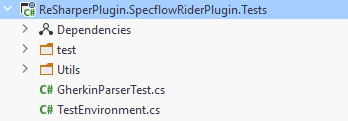Contributing can be a rewarding way to teach, improve existing skills, refine the software you work with and build experience. Contributing to open source can also help you grow and learn more in your career or even change careers!
By contributing to any of the SpecFlow products, you also have the chance to become a SpecFlow Community Hero! Please check the SpecFlow Community Hero Program for more details.
We do all of our development on GitHub. If you are not familiar with GitHub or pull requests please check out this guide to get started.
Other prerequisites to develop are :
- .NET 4.6.1 SDK
- Java SDK
and of course C# knowledge if you are looking to contribute by coding.
You can contribute by working on an existing bug/issue or report a new one, build a new functionality based on feature requests reported by SpecFlow community or if do not wish to code you can always contribute to writing documentation.
If you like to contribute by fixing a bug/issue, please start by checking if the issue has already been reported.
Guidelines for bug reports:
-
Use the GitHub issue search — look for existing issues.
-
Check if the issue has been fixed — try to reproduce it using the
masterbranch in the repository. -
Isolate and report the problem — ideally create a reduced test case. Fill out the provided template.
We label issues that need help, but may not be of a critical nature or require intensive SpecFlow knowledge, to Up For Grabs. This is a list of easier tasks that anybody who wants to get into SpecFlow development can try.
Feature requests are welcome. But please take a moment to find out whether your idea fits with the scope and aims of the project. It's up to you to make a strong case to convince the community of the merits of this feature. Please visit our feature request page to check out the existing requests and vote on the ones already proposed by the community. Since much of the work is done by volunteers, someone who believes in the idea will have to write the code. Please provide as much detail and context as possible.
As mentioned before, we do all of our development on GitHub. If you are not familiar with GitHub or pull requests please check out this guide to get started.
Please adhere to the coding conventions in the project (indentation, accurate comments, etc.) and don't forget to add your own tests and documentation. When working with Git, we recommend the following process.
in order to craft an excellent pull request:
-
Fork the project, clone your fork, and configure the remotes.
-
Configure your local setup by cloning the SpecFlow for Rider repository.
-
If you cloned a while ago, get the latest changes from upstream.
-
Create a new topic branch (off of
master) to contain your feature, change, or fix.IMPORTANT: Making changes in
masteris discouraged. You should always keep your localmasterin sync with upstreammasterand make your changes in topic branches. -
Commit your changes in logical chunks. Keep your commit messages organized, with a short description in the first line and more detailed information on the following lines. Feel free to use Git's interactive rebase feature to tidy up your commits before making them public.
-
Newly added tests should pass and be green:
-
Push your topic branch up to your fork.
-
Open a Pull Request with a clear title and description.
-
If you haven't updated your pull request for a while, you should consider rebasing on master and resolving any conflicts.
Some important notes to keep in mind:
- Never ever merge upstream
masterinto your branches. You should alwaysgit rebaseonmasterto bring your changes up to date when necessary. - Do not send code style changes as pull requests like changing the indentation of some particular code snippet or how a function is called. Those will not be accepted as they pollute the repository history with non functional changes and are often based on personal preferences.
- By submitting a patch, you agree that your work will be licensed under the license used by the project.
- If you have any large pull request in mind (e.g. Implementing features, refactoring code, etc), please ask first otherwise you risk spending a lot of time working on something that the project's developers might not want to merge into the project.
Rider:
- Open <SpecflowRiderPlugin.sln> with Rider
- Build\Build Solution
CLI:
- Execute buildPlugin.ps1 in PowerShell
Please join our dedicated discord server to ask questions from the SpecFlow team and also get to work with other contributors.
Thank you for your contributions!

